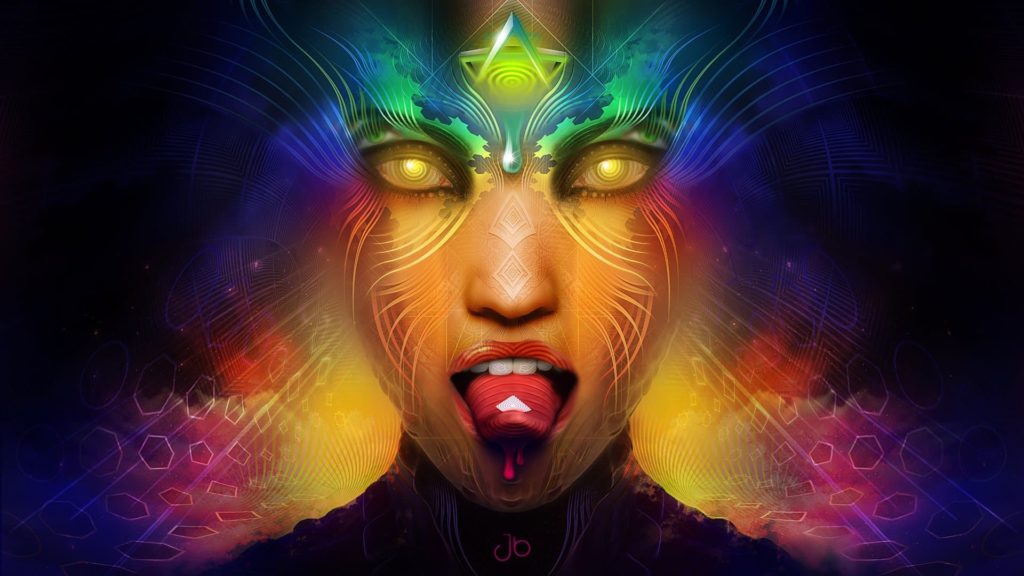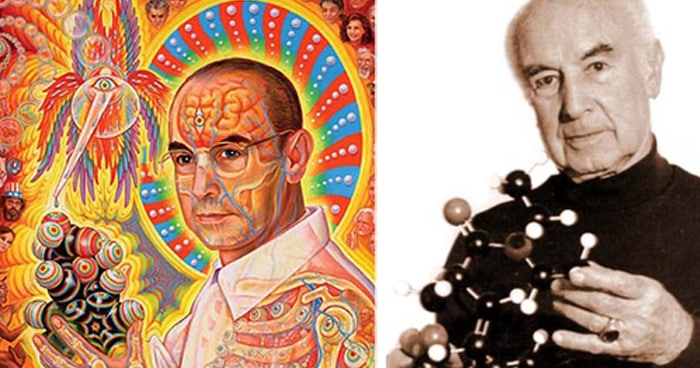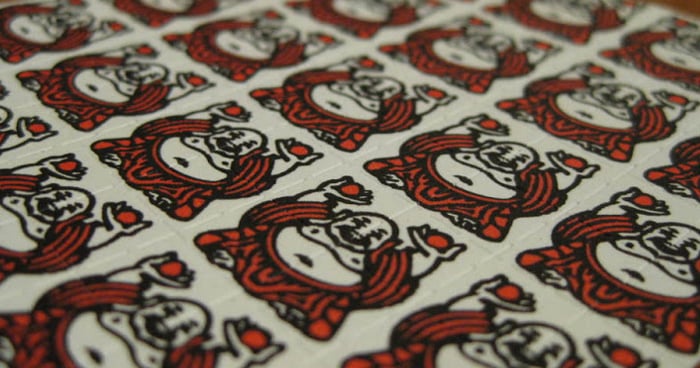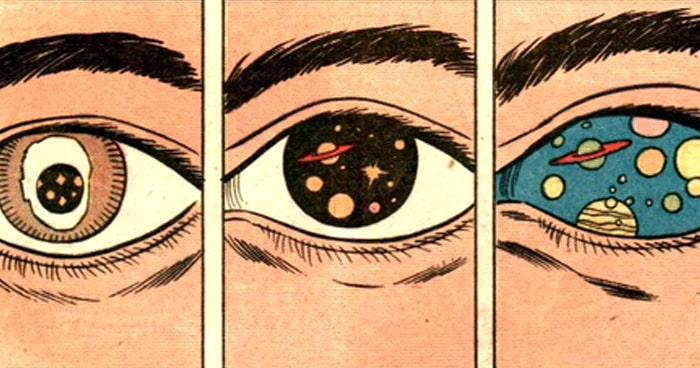The History and Future of LSD

A Little History…

Artwork by Alex Grey
LSD was first synthesized in 1938 by Albert Hofmann while he was in Switzerland working for the pharmaceutical-chemical department of Sandoz Laboratories, with his co-worker professor Arthur Stoll (founder/director of the pharmaceutical department). During their experiments, Hofmann wound up deriving a chemical called ergotamine, which comes from a grain fungus that typically grows on rye – and the original intention of its synthesis was for obtaining a respiratory and circulatory stimulant (aka: analeptic) with no effects on the uterus.
The laboratory name for the compound discovered was given the acronym for the German term “Lyserg-säure-diäthylamid” (Lysergic acid diethylamide), followed by a sequential number: LSD-25.
Hoffman’s discovery lay dormant, until April 16, 1943, when he made a decision to reexamine the LSD. During the process of re-synthesizing, he accidentally touched his hand to his mouth, and ingested a small amount of the substance, which subsequently caused him to have a psychedelic experience. He described the experience by saying:
“… affected by a remarkable restlessness, combined with a slight dizziness. At home I lay down and sank into a not unpleasant intoxicated[-]like condition, characterized by an extremely stimulated imagination. In a dreamlike state, with eyes closed (I found the daylight to be unpleasantly glaring), I perceived an uninterrupted stream of fantastic pictures, extraordinary shapes with intense, kaleidoscopic play of colors. After some two hours this condition faded away.”
Three days later, on April 19, 1943, Hofmann then intentionally ingested 250 micrograms of LSD – a day which has affectionately become known as “Bicycle Day,” because after starting to feel the psychedelic effects, he rode home on a bike, and this is what is known as the first intentional acid trip.
In 1963, Sandoz’s patents on LSD expired – and during this time the beginning of the first “psychedelic renaissance” saw its way through popular culture. Thinking minds such as Aldous Huxley, Timothy Leary, and Alan Watts, were passionate advocates of the consumption of LSD as a means of expanding consciousness, and increasing awareness of self in relation to the world.
What is LSD?

“LSD burst over the dreary domain of the constipated bourgeoisie like the angelic herald of a new psychedelic millennium. We have never been the same since, nor will we ever be, for LSD demonstrated, even to skeptics, that the mansions of heaven and gardens of paradise lie within each and all of us.” – Terence McKenna
LSD is a psychedelic of the ergoline family, meaning it consists of chemical compounds whose structural skeleton contains a diverse range of alkaloids.
In its pure form it is a colorless, odorless, tasteless solid – whose potency is able to last for years if stored away from light and moisture at a low temperature. It is extremely sensitive to oxygen, UV light and chlorine.
It can come in the form of a liquid solution, which is either distributed in small vials or, more commonly, sprayed onto sugar cubes. LSD also can come in the form of tablets in large (4.5–8.1 mm diameter), heavyweight (≥150 mg), round, high concentration (90–350 µg/tab) dosage units to small (2.0–3.5 mm diameter) lightweight (as low as 4.7 mg/tab tablets known as “Microdots”. Various shapes include cylinders, cones, stars, spacecraft, and heart shapes.
Perhaps the most popular form of LSD comes in the way of “blotter paper”, which is made by dipping a preprinted sheet of blotting paper into an LSD/water/alcohol solution.
The LSD Experience

“It gave me an inner joy, an open mindedness, a gratefulness, open eyes and an internal sensitivity for the miracles of creation. I think that in human evolution it has never been as necessary to have this substance LSD. It is just a tool to turn us into what we are supposed to be.” – Albert Hofmann
The effects of an LSD “trip” vary from person to person – but typically last anywhere from 6 to 14 hours, with effects beginning around 30 to 90 minutes after ingestion.
Timothy Leary was an advocate for the notion of “set and setting” – with the “set” being the mindset of the user, and the “setting” being the physical/social environment in which the trip takes place. Leary believed that if a user is in an unsettling environment or not mentally prepared for the experience – it will result in an extremely unpleasant experience, ie: panic attack, or extreme anxiety .
When in a comfortable/relaxed space, effects from an LSD trip include…
- dissolution of separateness from self and “other”
- “ego death”
- enhanced sensory experiences of emotions and memories
- altered sense of time (ie: time revealing itself as an illusion, changing speed, or stopping)
- visions animated geometric, fractal, or “breathing” patterns
- eidetic imagery (colored patterns with eyes closed)
- intensified colors and brightness/sense of sparkling or halos
- intensified experience/feeling of music and sound
- distortion of spatial dimensions
- disassociation
- feelings of bliss/euphoria
- a sense of enlightenment/understanding
Physical reactions from the substance include (but are not limited to) reduced appetite, alertness, and pupil dilation. Other less-common physical reactions during an LSD trip are numbness, nausea, weakness, hypothermia or hyperthermia, elevated blood sugar, goose bumps, increased heart rate, jaw clenching, perspiration, saliva production, mucus production, hyperreflexia, and tremors.
In the event of an overdose with LSD (a dosage between 1,000 to 7,000μg per 100ml & 2.1 to 26 ng per ml) medical assistance will be required to negate negative side effects, and to prevent tachycardia (rapid heart rate) or hyperthermia.
After Effects of LSD
“Nobody stopped thinking about those psychedelic experiences. Once you’ve been to some of those places, you think, ‘How can I get back there again but make it a little easier on myself?’” – Jerry Garcia
After a positive experience with LSD, you may feel a bit tired or drained of energy for the following day. Many users report having long-term psychological and emotional changes, especially relating to the perspective of life, and spirituality. These insights and feelings tend to stay with you for the long run, and you may experience an “after glow” which lasts anywhere from a few hours, to a few weeks after.
In the event of a “bad trip” you may experience traumatic feelings such as anxiety, and panic – but these feelings dissolve after a few weeks (at the most).
LSD Legality
LSD is considered a Schedule I controlled substance under the Controlled Substances Act (CSA), and this is because the Federal Government believes there is no current medical usage, and it has a high abuse potential.
Federal penalty for a first offense of LSD possession is a minimum fine of $1,000.00 and a maximum of one year in prison – with additional offenses raising the prison time to as much as three years.
Penalties for LSD possession are not always based on the number of offenses, but instead – relate to the amount of substance involved. For example, if you are caught with an amount of up to 10 grams, you may face a fine of up to $2 million dollars and anywhere from 5-40 years in jail…even if it’s your first offense.
The Future of LSD
In 2014 MAPS (The Multidisciplinary Association for Psychedelic Studies) completed the first double-blind, placebo controlled study of the therapeutic use of LSD since the early 1970s, and there results were very positive.
Stating: “completed Phase 2 pilot study in 12 subjects found positive trends in the reduction of anxiety following two LSD-assisted psychotherapy sessions. The study results also indicate that LSD-assisted psychotherapy can be safely administered in these subjects, and justify further research.”
“The study was a success in the sense that we did not have any noteworthy adverse effects,” reports Principal Investigator Peter Gasser, M.D., a private practice psychiatrist in Solothurn, Switzerland. “All participants reported a personal benefit from the treatment, and the effects were stable over time.”
With new research continuing to be discovered and explored, the future of LSD may be promising in relation to its application as a therapy – but for now, it is still highly illegal, and (as always) we advocate proper research and safety when it comes to this particular substance.
Links…
EntheoNation – the process of awakening the Divine within.
Entheo Nation – a global tribe of visionary people living life at the cutting edge of awakening.
EntheoNation is a web show featuring visionaries pioneering the cutting-edge of awakening through psychedelic science, modern shamanism, & new paradigm lifestyles.
Our vision is an environmentally sustainable, socially-just, spiritually-fulfilling, and evolved human presence on this planet, one that integrates ancient wisdom, with modern times.
